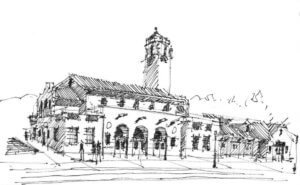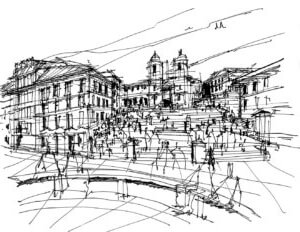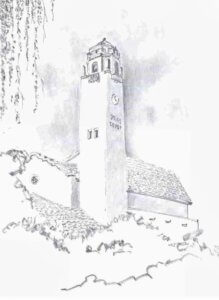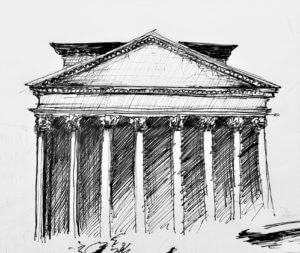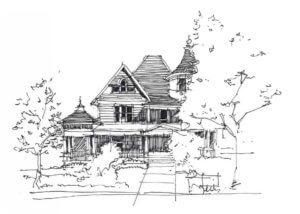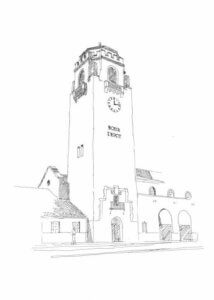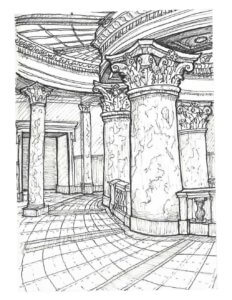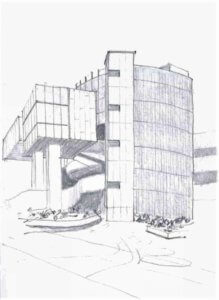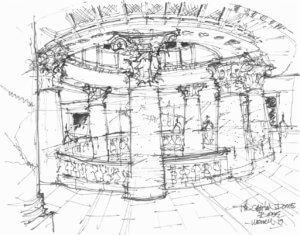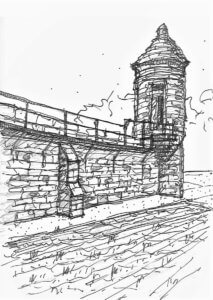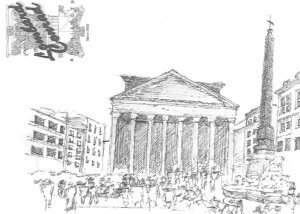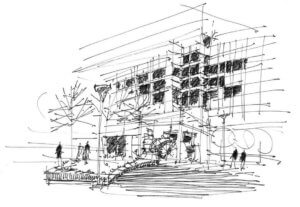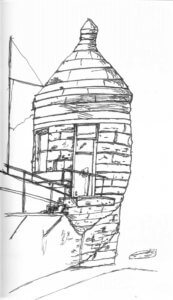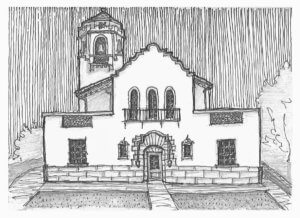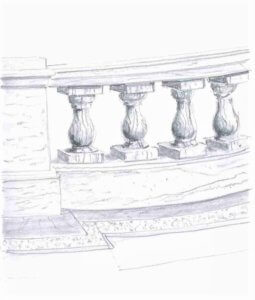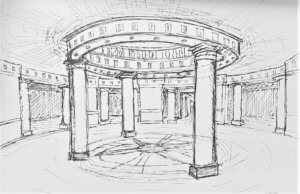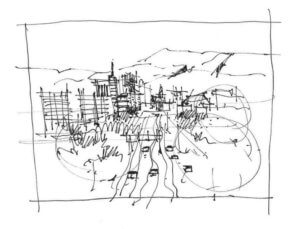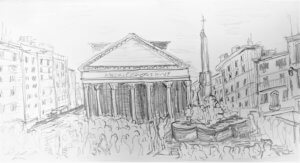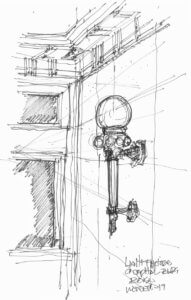Thinking with our Hands, Drawing with our Minds
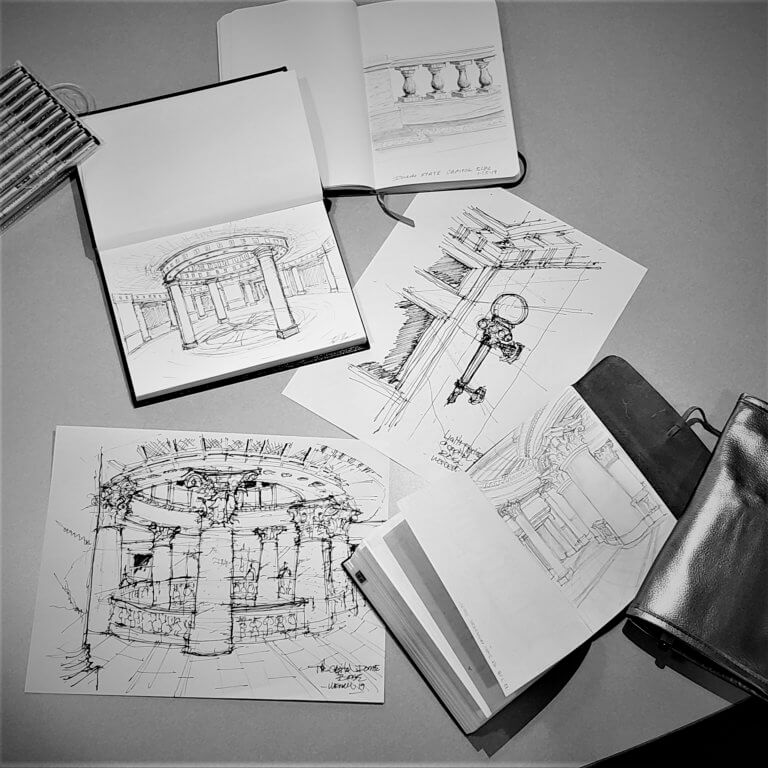
PRESERVING THE EMBODIED WISDOM OF SKETCHING AND DRAWING
There is embodied wisdom in sketching and drawing. The architect’s ability to think with their hands and draw in their minds has become a powerful tool for imagining the spaces of tomorrow. From neurological and haptic connections between the eyes, mind, and hand to serving as a mnemonic device to improve our recollection, the creative act of drawing is important for not only the design professional but also for the non-artist.
Drawing and architecture have a long history. In fact, one of our very first books on architecture, written in the first century by Roman architect Marcus Vitruvius Pollio, expressed the need for architects to be educated and “skillful with the pencil.”[1] It wasn’t until more than a thousand years later during the Renaissance that the relationship between architecture and drawing was codified by Leon Batista Alberti.[2] Since then drawing and sketching have been part of the creative process in the design of billions of square feet across the globe.
SHIFTS IN THE ART OF DRAWING
Sometimes there is a love-hate relationship when new technology is introduced into the architectural profession. In his book The Hunchback of Notre Dame, Victor Hugo describes architecture as the “great book of the human race.” But with the arrival of Guttenberg’s printing press and its end product the book, Gothic architecture’s function as a non-literary device in communicating Biblical stories was consequently threatened. “This will kill that. The book will kill the edifice,” he declared.[3] While a technological advance wasn’t the means of killing architecture’s function as a mute text, technology is beginning to threaten the art of drawing.
Architectural design took a major shift in the early 1990s from “pen, pencil and paper to keyboard, mouse and screen” when computer-aided drafting (CAD) emerged. It became an extremely “efficient tool for churning out construction drawings.”[4] Such efficiency saves money and has driven the design industry and architecture schools to embrace software and let go of the pencil. With the rise of additional technological advances in our day, it is not surprising that some contemporary architects and critics have been quick to declare that drawing is now dead.[5] Indeed, we live in an age of virtual reality simulation, photo realistic renderings, parametric modeling, computer-aided drafting, computational design, and building information modeling (BIM). But is drawing really dead for architects and designers?
A symposium titled “Is Drawing Dead?” was held at the Yale School of Architecture in 2012 to discuss this matter. Technologically driven architects and academics (such as Greg Lynn and Andrew Witt of Gehry Technologies) were contrasted by more traditional, phenomenological, and historical perspectives (including Juhani Pallasmaa and Michael Graves) each arguing their case for or against drawing in the profession.[6] Later that same year, a New York Times article titled “Architecture and the Lost Art of Drawing” reconsidered the arguments by asking: “Are our hands becoming obsolete as creative tools? Are they being replaced by machines? And where does that leave the architectural creative process?” For architect Michael Graves, “Architecture cannot divorce itself from drawing, no matter how impressive the technology gets. Drawings are not just end products: they are part of the thought process of architectural design.”[7]
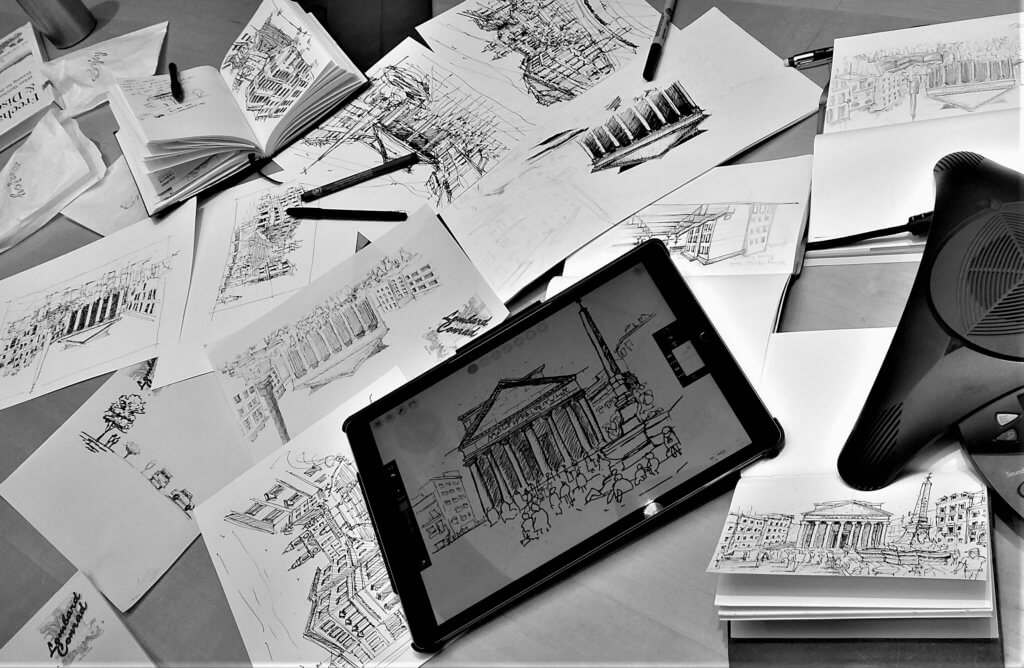
DRAWING AS DISCOVERY
At times, sketching can be used as a means of discovery and exploration to get ideas out of the mind and onto paper. “When sketching an imagined space, or an object being designed, the hand is in a direct and delicate collaboration and interplay with mental imagery,” explains Finnish architect Juhani Pallasmaa. “The image arises simultaneously with an internal mental image and the sketch mediated by the hand” emerges as the result.[8] Others have described sketching and doodling as a way of “pondering space” which is much more fluid than the restraints of computer produced imagery.[9] “When I draw and paint,” explains New York architect Steven Holl, “I connect the subjective and the objective.” He continues, “It’s a way of open thinking and free-feeling, and it’s unpredictable. In order to get closer to a dreamlike subjectivity, I like to make these little drawings and paintings at dawn, before breakfast.”[10]
For architects, drawing is a tool to graphically think about spatial relationships, convey ideas, and diagram concepts among other things. Sketching is also a great way to engage clients, explains architect David Obitz in a recent article in the Wall Street Journal. “Doing it digitally” is too “refined that there’s not a lot left to your imagination.” With a hand-drawing, however, a client “can still add their dreams to it, they can still have their creative force” engaged, he argues.[11]
When architects and designers study other buildings, analytical sketching enables one to understand through quick diagrams the parti or overarching concept of a building such as its massing, form, organization, and structure. Hand-produced measured drawings, on the other hand, help architects not only verify the existing conditions of a space but they can also be used to study building precedents in the field to learn about specific proportions and details. Perspectival field sketching is another form whereby light and shadow, texture and materials, or ambiance and atmosphere can be studied and captured. The drawings and sketches of architects and designers become evidence of the creative process, but they also serve as future artifacts for the history of architecture. Computer imagery and digital drawings are more difficult for museums and libraries to archive than hand drawn artifacts, explains C. Ford Peatross, curator at the Library of Congress.[12]
The act of drawing, however, is not limited to use by design professionals. It can be for all walks of life as a means of discovery and learning. Not every drawing or sketch should be thought of as a polished end-product or work of art. “We have misfiled the significance of drawing because we see it as a professional skill instead of a personal capacity,” argues D.B. Dowd. “This essential confusion has stunted our understanding of drawing and kept it from being seen as a tool for learning above all else.”[13] Sketching affects the way we see the world. Likewise, the lens through which we observe the world manifests itself in our sketches. “A drawing does not reproduce the tree as it manifests itself in the objective reality,” explains Pallasmaa. Instead, “the drawing records the way the tree is seen or experienced.”[14] Above all, sketching and drawing can be a tool for learning from and discovering the world around us.
EYE, MIND, HAND CONNECTIONS
“Drawings express the interaction of our minds, eyes and hands,”[15] writes Michael Graves. Part of the embodied wisdom in drawing, therefore, is found in the relationship between the eyes, mind, and hand. “Sketching and drawing are spatial and haptic exercises that fuse the external reality of space and matter and the internal reality of perception, thought, and mental imagery into a singular and dialectic entity,” argues Pallasmaa.[16]
Every act of sketching or drawing results in neurological connections between the hand and eyes. These connections produce and embed three distinct sets of images in our memory. As Pallasmaa explains, there is “the drawing that appears on the paper, the visual image recorded in my cerebral memory, and a muscular memory of the act of drawing itself. All three images are not mere momentary snapshots, as they are recordings of a temporal process of successive perception, measuring, perception, evaluation, and re-evaluation.”[17] When we are sketching we are not only thinking with our hands but we are also drawing with our minds.
DRAWING AS MEMORY
New research is saying that drawing is beneficial for the non-artist as well. A recent study by researchers at the University of Waterloo, discovered that drawing information had a greater tendency to enhance memory recall than writing down the same information in words. They concluded that “drawing improves memory by encouraging a seamless integration of semantic, visual, and motor aspects of a memory trace.”[18] In short, if you need to remember something, draw it.
The practice of drawing and sketching creates an embodied, muscular, and mental memory. As Pallasmaa reflects on his own experience, he writes:
“This multiple nature of the sketch, its layered exposure, as it were, makes me remember vividly each one of the hundreds of scenes that I have sketched during fifty years of my travels around the world, whereas I can hardly recall any of the places that I have photographed as a result of the weaker embodied recording of taking a photograph.”[19]
Drawing can be a tool for anyone wanting to improve their recollection, but it can also create lasting embodied memories of place.
In summary, drawing and sketching should not be viewed as a dead practice for architects despite technological advances. It has a rich history stretching back over the centuries and continues to be used as a tool for discovery, observation, and imagination. Sketching and drawing are very much a living practice producing embodied memories and connections between our eyes, mind, and hands. Let us preserve the embodied wisdom found in the process of sketching by thinking with our hands and drawing with our minds.
NOTES
[1] Marcus Vitruvius Pollio, Vitruvius: The Ten Books on Architecture, trans. Morris H. Morgan (New York:
Dover, 1960), Book 1, Chapter 1:3, p.6.
[2] See arguments in Leon Battista Alberti, The Ten Books of Architecture (New York: Dover, 1986).
[3] See book V, chapter II in Victor Marie Hugo, Notre Dame de Paris (New York: P.F. Collier and Sons, 1917), Book V, Chapter II.
[4] “Architecture’s Dying Art,” The Washington Times, 28 July 2007. Accessed on 17 October 2018, https://www.washingtontimes.com/news/2007/jul/28/architectures-dying-art/
[5] See, for instance, recent arguments outlined in David Ross Scheer, The Death of Drawing: Architecture in the Age of Simulation (New York: Routledge, 2014).
[6] “Yale School of Architecture Symposium asks: ‘Is Drawing Dead?’” Yale News (3 February 2012). Accessed 3 October 2018, https://news.yale.edu/2012/02/03/yale-school-architecture-symposium-asks-drawing-dead
[7] Michael Graves, “Architecture and the Lost Art of Drawing,” New York Times (1 September 2012). Accessed 3 October 2018, https://www.nytimes.com/2012/09/02/opinion/sunday/architecture-and-the-lost-art-of-drawing.html
[8] Juhani Pallasmaa, The Thinking Hand: Existential and Embodied Wisdom in Architecture (Wiley, 2009), p. 91
[9] “Architecture’s Dying Art.”
[10] Cited in “Architecture’s Dying Art.”
[11] Lisa Selin-Davis, “The Dying Art of Creating a Home with Pen and Paper,” The Wall Street Journal (17 October 2018). Accessed 17 October 2018, https://www.wsj.com/articles/the-dying-art-of-creating-a-home-with-pen-and-paper-1539789522
[12] Cited in “Architecture’s Dying Art.”
[13] Cited in Anne Quito, “Drawing is the Best Way to Learn, even if you’re no Da Vinci,” Quartzy, September 15, 2018. Accessed 12 October 2018, https://qz.com/quartzy/1381916/drawing-is-the-best-way-to-learn-even-if-youre-no-leonardo-da-vinci/. I am grateful to Ben Bernier for bringing this article to my attention.
[14] Pallasmaa, The Thinking Hand, p. 92.
[15] “Architecture and the Lost Art of Drawing.”
[16] Pallasmaa, The Thinking Hand, p. 89.
[17] Ibid, p. 90.
[18] Jeffrey D. Wammes, Melissa E. Meade, Myra A. Fernandes, “The drawing effect: Evidence for reliable and robust memory benefits in free recall,” The Quarterly Journal of Experimental Psychology, 2016; 69 (9): 1752 DOI: 10.1080/17470218.2015.1094494
[19] Pallasmaa, The Thinking Hand, p. 90.

